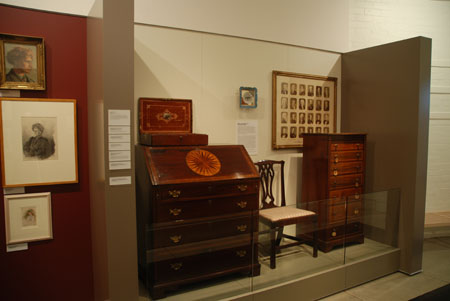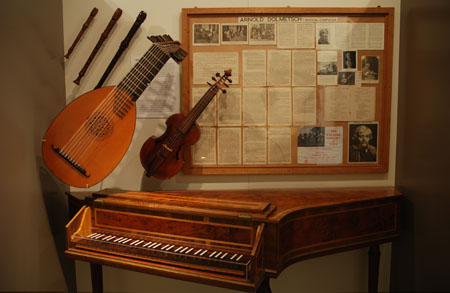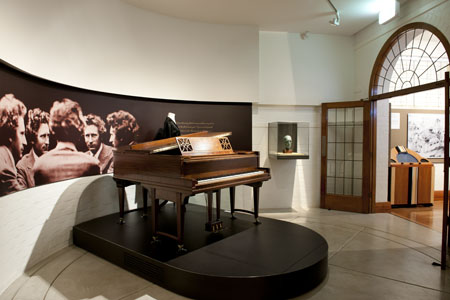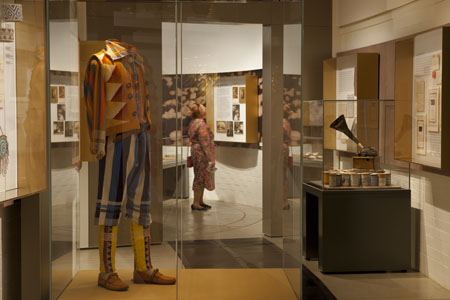With its glass-brick windows and blank brick walls it looks at first glance like an oversize modernist ablutions block, a comparison all-too familiar to its staff. Indeed, the University of Melbourne's legendary vice-chancellor Sir John Medley (1891–1962) compared it to a public lavatory; fortunately, wiser counsel deterred him from tearing it down. In fact it is the Grainger Museum, Australia's only purpose-built autobiographical museum, recently and triumphantly rebuilt, refurbished and reopened.[1] The Grainger Museum brilliantly and refreshingly interprets and celebrates the life of Australia's most internationally known composer, Percy Aldridge Grainger (1882–1961). Long fascinated by the composer, man-of-ideas and self-described 'life-master' (his Nordic-inspired 'blue-eyed English' synonym for 'genius') I was fortunate to be able to fulfil a long-cherished desire and visit the Grainger Museum close to the 50th anniversary of Grainger's interment (contrary to his wishes) in West Terrace Cemetery in Adelaide in March 1961.
The task of selection alone deserves praise, as does the restraint the curators have exercised. The larger Grainger collection, of 125,000 items, includes his scores, published and manuscript, 4000 books, 15,000 photographs and any number of musical instruments, from a dozen pianos (including the upright on which he learned as a 5-year-old) and the wacky-looking machines with which he created his experimental music in the 1950s. Formerly compacted into the tiny Grainger building, the collection is now professionally conserved and suitably housed in a climate-controlled store and in the Baillieu Library. The selection on display includes more than 50 of the canes with which Grainger sought sexual satisfaction through flagellation, a need that he documented abundantly. In the spirit of Grainger's candour, the museum deals candidly if briefly with what he called the 'Lust Branch' of his life and collection. It displays (just out of the likely eye line of minors) a horrific photograph that Grainger took in a mirror, revealing his buttocks scored by cuts and welts. Grainger spared nothing in documenting his own life — he took the photograph in question specifically for the museum — and the museum has bravely and rightly acted in that spirit.
Though the museum functioned well, a decade ago it became clear that leaky drains and roof imperilled the building (and indeed the staff, who suffered from persistent chest infections). A survey disclosed the need for massive repairs and the rescue work prompted a major refurbishment of the galleries as well as the building fabric. Though precipitated by a structural crisis, the refurbishment, opened in October 2010, has created an attractive, informative and sympathetic interpretation, hugely successful on several measures. The Grainger Museum's staff and consultants should be commended for the care and scholarship they have brought to this enterprise, while the University of Melbourne should be congratulated not only for not following Medley's advice, but also for backing the venture substantially.

Highly respectful of his own talent, Grainger documented all aspects of his life with a thoroughness that would be risible were it not founded on the boyish, unselfconscious enthusiasm he brought to everything he did. In establishing his own museum in the 1930s Grainger characteristically designed his own display furniture and created his own interpretative panels, which he called 'legends'. Not only have the designers included several of his handmade, stencilled panels in the new museum, but the panel design they have adopted, with its concise text and clear design, also makes reference to Grainger's intentions. In this the museum is effectively a collaboration between its current custodians and the man who founded it, and it gains strength from that surely unique partnership.

No museum devoted to a composer (or indeed music) can do without sound, and nothing is more sadly silent than an unplayed instrument. Not only does the Grainger Museum play Grainger's music through the galleries more-or-less continuously, but through the miracle of the electric player piano (developed just as Grainger became notable) we can also hear Grainger himself play his music. The player piano was being repaired during my visit, so I heard portions of the Grieg piano concerto played by Grainger, but just as I was sitting reflecting on the achievement of the renewed museum the machine came good and — of all things — 'Country gardens' (the seemingly prissy tune most associated with Grainger popularly and which he came to loathe) burst forth in all its lyrical, percussive glory. In Grainger's hands 'Country gardens' is as full-blooded as the man.

At the core of Grainger's life was his relationship with two women: his mother, Rose, and his wife, Ella. Rose, whose death (she probably committed suicide, unbalanced by the syphilis she contracted from her husband 30 years before), devastated Grainger, and one of the most poignant exhibits is the display of the contents of her handbag on the day she fell from a window in Chicago in 1922. Grainger preserved and catalogued the items minutely, including the gloves she was wearing that day and a hank of her hair, honey-brown, even at 60. His wife, Ella, whom Grainger doted on as his 'Nordic princess', shared his life and his eclectic obsessions from 1926, including the creation of the museum he funded in the city in which he grew up. The score of 'To a Nordic princess', performed at their wedding before an audience of 25,000 at the Hollywood Bowl, is one of the musical treasures of the collection.
Grainger, fascinating in so many ways, is not an easy man to like or understand. His 'blue-eyed English', for instance, arouses disquiet, because it arose from Grainger's racist deprecation of Latin or Romance languages. His determination to restore English to its supposedly pure Nordic roots at least considered language as entailing meaning. But its manifestation was often risible: 'argument' became 'talk-wrestlement', education 'mind-tilth', morality 'ought-code' and audience 'listen-host'. The Grainger Museum strives to do justice to the complexities and contradictions of his life and ideas. It documents not only his idiosyncratic musical ideas (including his experiments with 'Free Music' in old age) but also his fads, such as for beadwork inspired by North American and African cultures, his passion for sailing ships and the colourful towelling clothing of his own design. The museum shows how he was a product of his time — in the small but exquisite collection of Arts and Crafts furniture, or the relics of his friendships with Norman Lindsay (another sexual rebel) and his devotion to Delius. Together the galleries evoke a lost aesthetic world. Is this a museum largely for specialists or devotees? Perhaps, but though I like the sounds that Grainger created I am neither.

Disappointments in the new museum are few. The gallery devoted to Melbourne's musical culture, soundly researched and worthy though it is, seems anaemic and academic when set alongside Grainger's robust bohemianism and eccentricity. (On the other hand, as the Grainger Museum is located next door to the Melbourne Conservatorium of Music, the display constitutes a first-class teaching device for its students.) An interactive device giving visitors further entrée to his collection and his music is less than intuitive (I had to be shown how to use it) and seems to deliver rather less than it promises. (The helpful gallery assistant acknowledged that headphones would help; a refinement in train, perhaps.) These shortcomings are minor in the context of the powerful encounter with Grainger that the museum offers.
Why should the Grainger Museum offer visitors such a satisfying experience? For me the pleasure was in seeing artefacts and mementos associated with Grainger that made the man real (and not least to hear his voice, albeit very softly on the not-altogether satisfactory interactive device). But more than that must surely be that the museum integrates Grainger, the man, his music and his passions (in every sense), through a collection he created, selected and, to a large extent described, captioned and interpreted, all displayed in a building that he helped to design with that specific purpose in mind. Moreover, the refurbishment and reinterpretation of Grainger's life, art and collection has been accomplished by curators and designers with a deep knowledge of his life and work, and with a sympathy toward his ideals in founding and arranging the museum in the first place. The result is a museum experience that is entirely and literally in harmony.
| Exhibition: | The Grainger Museum |
| Institution: | University of Melbourne |
| Curators: | Brian Allison and Astrid Krautschneider |
| Designer: | Lucy Banyan, Banyan Wood Pty Ltd |
| Venue/dates: | reopened 17 October 2010 |
| Floor space: | 292 square metres) |
1I thank the Grainger Museum's co-curators, Mr Brian Allison and Ms Astrid Krautschneider and their colleagues for their assistance during my visit to the museum.
2The Grainger Museum is the subject of several essays in Pamela Thwaites's recent The New Percy Grainger Companion (Boydell Press, Woodbridge, Suffolk, 2010), notably one by co-curators Brian Allison and Astrid Krautschneider on the collection.
3John Bird's biography, Percy Grainger (P Elek, London, 1976; Oxford University Press, New York, 1999) still provides the best life of Grainger.
